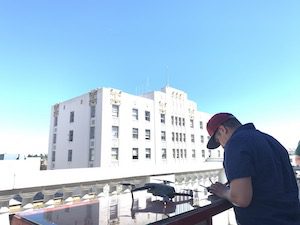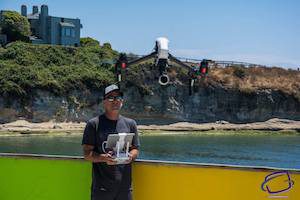In November 2018 when Daniel Hernandez joined TeamTam, the personal drone footage he shared made the next step clear. He needed his FAA Certificate so that this aerial option could be offered to Tam clients. Current regulations dictate that recreational flyers do not need any licensing, but commercial flyers do. And the process is quite involved. Daniel researched and studied for several weeks before taking the test. You can find certification information and study guides here.
The Value of FAA Certification
In April, Daniel received his FAA Certification to pilot a UAS (Unmanned Aircraft System), often called a UAV or more commonly a drone. Incorporating aerial footage in our projects is an asset to our clients; local projects can feature the natural beauty of our surrounding shores and mountains, event coverage can capture dramatic perspectives, and having t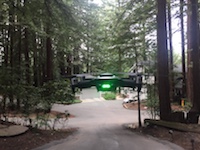 his option available in creative brainstorming is exciting for everyone. It provides this additional vantage point that we can easily add to the production mix along with our other camera platforms. Daniel shoots for our clients with our DJI Mavic 2 Zoom, the only product on the market with obstacle detection on all six sides. It’s also smaller and quieter, has superior tracking capability, and has a Hasselblad camera that delivers amazing quality.
his option available in creative brainstorming is exciting for everyone. It provides this additional vantage point that we can easily add to the production mix along with our other camera platforms. Daniel shoots for our clients with our DJI Mavic 2 Zoom, the only product on the market with obstacle detection on all six sides. It’s also smaller and quieter, has superior tracking capability, and has a Hasselblad camera that delivers amazing quality.
Another benefit is the cost-savings. Prior to drones, we’d hire a helicopter, pilot, and special rigging, which could cost up to $7,000 per day. Before having a licensed drone pilot on TeamTam, we would hire skilled, outside resources to film our aerial shots. Our office manager, Diane Dobbs, sums up this key perk for the businesses we work with. “In the past, we’ve had to hire a licensed pil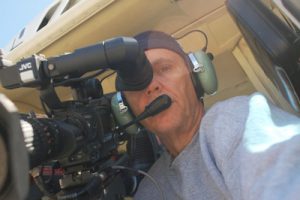 ot to do aerial photography at a significant cost, often more than $2K per day. Being able to do our own filming
ot to do aerial photography at a significant cost, often more than $2K per day. Being able to do our own filming 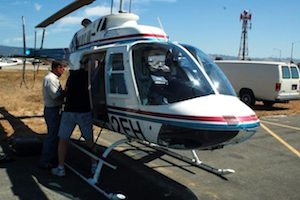 reduces our expenses and we can pass along those savings to our clients.” While experienced and licensed drone operators are well worth the cost, we’re happy we can meet this need in-house.
reduces our expenses and we can pass along those savings to our clients.” While experienced and licensed drone operators are well worth the cost, we’re happy we can meet this need in-house.
When do you need a permit to fly a drone?
The permit process for flying in public space varies from city to city, and for video companies this task of learning the restrictions will generally fall to the producer. Starting at your city’s web site is the first step, and a phone call to the appropriate office is a good idea as well, considering how quickly the regulations are changing. Be prepared to provide the pilot’s FAA Certificate and proof of liability insurance. While current regulations only require this for commercial uses, Daniel foresees a near future when all drones will need to be registered and licensed – for safety as well as privacy concerns. He also highly recommends that anyone flying a drone, even as a hobby, read up on FAA regulations regarding airspace and use. This is particularly important if you plan on flying in an area with an airport or heliport or in the flight path of either. Knowing the guidelines could spare you a headache and maybe save your drone from a premature rough landing.
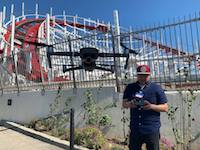 Some private clients and municipalities require proof of both the FAA certification and the insurance coverage. The penalties for not producing this documentation when required, or for violating other FAA rules, can vary from a warning letter, suspension or revocation of the pilot’s license, to substantial fines. Diane handles much of the paperwork surrounding the permitting and insurance requirements for use of our drone. The risks to property may be minimal, according to Diane “The drone only weighs 2 pounds. If it strikes a hard object like a fence, it will break and fall to the ground. This I know from personal experience.”
Some private clients and municipalities require proof of both the FAA certification and the insurance coverage. The penalties for not producing this documentation when required, or for violating other FAA rules, can vary from a warning letter, suspension or revocation of the pilot’s license, to substantial fines. Diane handles much of the paperwork surrounding the permitting and insurance requirements for use of our drone. The risks to property may be minimal, according to Diane “The drone only weighs 2 pounds. If it strikes a hard object like a fence, it will break and fall to the ground. This I know from personal experience.”
Can you fly a drone over people or at night?
The FAA clearly prohibits flying over people. Any project that includes talent or production crew on the ground near aerial filming must provide a shield or safe covering. Flying over vehicles is permitted if the vehicles are part of the production. (They serve as their own shield.)
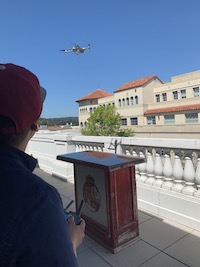 Another safety restriction to be aware of is flying at night. Because of the obvious risks of limited sightlines, drones can only fly at night with pre-authorization from the FAA. Pilots can fly thirty minutes before and after sunset only and must use anti-collision lights. Many models have built-in lights, and there are a number of after-market accessory lights that can be mounted on the drone. These lights must be visible for three nautical miles.
Another safety restriction to be aware of is flying at night. Because of the obvious risks of limited sightlines, drones can only fly at night with pre-authorization from the FAA. Pilots can fly thirty minutes before and after sunset only and must use anti-collision lights. Many models have built-in lights, and there are a number of after-market accessory lights that can be mounted on the drone. These lights must be visible for three nautical miles.
Aerial photography adds so much to our storytelling, and having this tool at our disposal is exciting for our crew and our clients. Keep an eye on our social media channels for birds-eye-view videos. And stay tuned for a future Tamgram featuring Daniel’s love of photography – on the ground and in the air.
In the meantime here’s our “Oh, What a View” video featuring footage filmed by Dan Carettoni of Santa Cruz Aerials in 2014, and updated with new dramatic footage shot by TeamTam’s Daniel this year.


